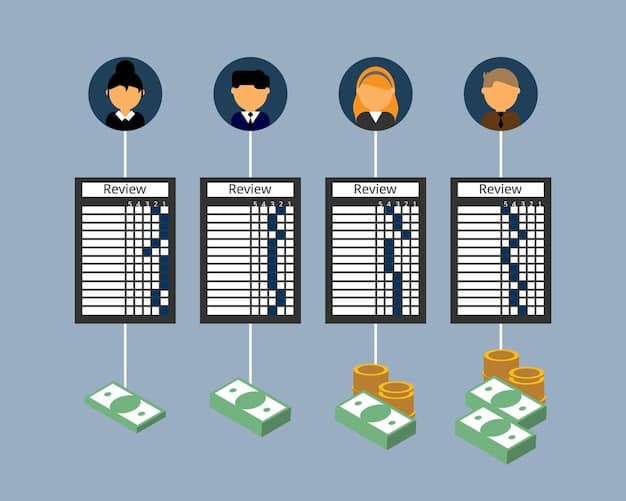MLS Salary Cap Tactics: Expert Strategies for a $5.2 Million Roster

MLS Salary Cap Strategies: How to Maximize Your Roster Within the $5.2 Million Limit focuses on navigating Major League Soccer’s constraints to build a competitive team, emphasizing strategic player acquisition, allocation of resources, and creative roster management within the salary cap.
Navigating the intricacies of Major League Soccer requires a keen understanding of the **MLS Salary Cap Strategies: How to Maximize Your Roster Within the $5.2 Million Limit**. With a fixed budget, building a competitive team demands not just talent identification but also astute financial planning and innovative roster construction.
Understanding the MLS Salary Cap
The MLS salary cap is a cornerstone of the league’s financial structure, designed to promote competitive balance among its teams. It sets a limit on the amount each team can spend on player salaries, preventing wealthier clubs from dominating the league through sheer financial power.
Understanding how the salary cap works is the first step in mastering MLS Salary Cap Strategies: How to Maximize Your Roster Within the $5.2 Million Limit. It’s not as simple as just staying under the $5.2 million mark; there are numerous exceptions, allowances, and roster designations that must be carefully managed.
Key Components of the Salary Cap
Let’s break down the main elements that MLS teams must consider when building their rosters:
- Base Salary: This is the guaranteed annual compensation for a player.
- Guaranteed Compensation: Includes a player’s base salary and any signing bonuses amortized over the length of their contract.
- Designated Player (DP) Rule: Allows teams to sign up to three players whose salaries exceed the maximum salary budget charge, with the team only charged a portion of their salary against the cap.
- Allocation Money: Funds that can be used to “buy down” a player’s salary budget charge or to sign new players. There are two types: General Allocation Money (GAM) and Targeted Allocation Money (TAM).
Effectively using these components is crucial for optimizing your roster within the constraints of the salary cap. Ignoring these elements can lead to inefficiencies and a less competitive team.

Strategic Player Acquisition
Acquiring talented players while staying within the MLS Salary Cap Strategies: How to Maximize Your Roster Within the $5.2 Million Limit requires a nuanced approach. It’s not just about finding the best players, but finding the best value for your money.
This involves scouting potential additions, understanding their market value, and creatively structuring contracts to minimize the impact on your salary cap.
Using Allocation Money Wisely
Allocation money is a powerful tool for roster management. Here’s how to make the most of it:
- Buying Down Salaries: TAM can be used to reduce a player’s salary budget charge if their compensation is between the Designated Player threshold and a set minimum.
- Signing New Players: Both GAM and TAM can be used to acquire players, either through transfer fees or by covering part of their salary.
- Strategic Trading: Allocation money can be traded to other teams, providing flexibility in roster construction and the ability to acquire targeted talent.
Smart use of allocation money can be the difference between a playoff contender and a team struggling to stay competitive. Diligently assessing needs and opportunities is key.
Leveraging the Designated Player Rule
The Designated Player (DP) rule is a vital aspect of MLS Salary Cap Strategies: How to Maximize Your Roster Within the $5.2 Million Limit, allowing teams to bring in high-profile talent that would otherwise be unaffordable under the cap.
While DPs command significant salaries, only a portion of their compensation counts against the salary cap, freeing up resources to build a more balanced roster.
Maximizing DP Impact
Choosing the right Designated Players is crucial for success. Here’s how to ensure you’re getting the most bang for your buck:
- Target Key Positions: Focus on signing DPs who can make a significant impact in crucial areas of the field, such as attacking midfielders, strikers, or center backs.
- Consider Marketability: DPs can also boost ticket sales and merchandise revenue, so consider players with a strong brand and fan appeal.
- Assess Team Chemistry: Ensure that your DPs fit well within the team’s culture and playing style. A disruptive DP can be more of a liability than an asset.
A well-chosen Designated Player can transform a team, elevating its performance on the field and attracting more fans to the stadium.

Roster Composition and Flexibility
Constructing a balanced roster is a core principle of MLS Salary Cap Strategies: How to Maximize Your Roster Within the $5.2 Million Limit. While star players are important, depth and versatility are crucial for navigating a long season and potential injuries.
This means building a team where players can fill multiple roles, and young talent can step up when needed. It’s about having a cohesive unit, not just a collection of individuals.
Utilizing Homegrown Players
MLS teams can sign players from their own development academies without them counting against the salary cap, providing a cost-effective way to bolster their rosters. These “homegrown” players often have a strong connection to the club and can contribute valuable minutes.
Investing in youth development is not just about finding future stars; it’s also about creating a sustainable pipeline of talent that can minimize your reliance on expensive acquisitions.
Contract Negotiations and Management
Securing favorable contracts is vital for effective MLS Salary Cap Strategies: How to Maximize Your Roster Within the $5.2 Million Limit. This involves not only negotiating salaries but also structuring contracts to maximize flexibility and minimize long-term financial burdens.
Understanding contract options, incentives, and clauses can give you a significant advantage in managing your roster and staying under the salary cap.
Creative Contract Structuring
Think beyond just the base salary when negotiating contracts. Consider these strategies:
- Performance-Based Incentives: Tie a portion of a player’s compensation to specific performance goals, such as goals scored, assists, or clean sheets.
- Option Years: Include club options that allow you to extend a player’s contract at a predetermined rate, providing flexibility in future roster decisions.
- Amortization of Signing Bonuses: Spread signing bonuses over the length of the contract to reduce the annual salary budget charge.
These strategies can help you attract top talent while staying within your budget constraints.
Long-Term Roster Planning
Effective MLS Salary Cap Strategies: How to Maximize Your Roster Within the $5.2 Million Limit require a long-term vision. Building a competitive team is not a one-year project; it’s an ongoing process of evaluation, development, and strategic decision-making.
This means continuously assessing your roster, identifying future needs, and planning for potential acquisitions and departures.
Building a Sustainable Roster
Consider these factors when planning for the future:
- Age Demographics: Maintain a balance of experienced veterans and promising young players.
- Contract Expirations: Track upcoming contract expirations and plan for potential replacements or re-signings.
- League Trends: Stay up-to-date on evolving MLS rules and regulations, as well as trends in player valuations.
By focusing on long-term sustainability, you can build a team that is not only competitive today but also well-positioned for future success.
In essence, mastering the MLS salary cap isn’t just about frugality; it’s about strategic investment, creative problem-solving, and a deep understanding of the league’s unique financial landscape. It’s about building a team that can compete, not just survive, within the $5.2 million limit.
| Key Aspect | Brief Description |
|---|---|
| 💰 Salary Cap Limit | Teams must build a roster within a $5.2 million salary limit. |
| ⭐ Designated Players | Allows up to three high-salary players with only a portion counting against the salary cap. |
| 💸 Allocation Money | Funds (GAM & TAM) used to buy down salaries or sign new players. |
| 🌱 Homegrown Initiatives | Signing players from the youth academy that don’t count against the cap. |
FAQ
▼
The MLS salary cap is a limit on the amount each team can spend on player salaries. It’s designed to promote competitive balance within the league, preventing wealthier teams from dominating through financial power.
▼
Allocation money comes in two forms: General Allocation Money (GAM) and Targeted Allocation Money (TAM). Teams can use these funds to reduce a player’s salary cap impact or sign new players.
▼
The Designated Player (DP) rule allows teams to sign up to three players whose salaries exceed the maximum budget charge, but their team is only charged a portion of the player’s salary against the cap.
▼
Roster flexibility enables teams to navigate injuries, changes in form, and tactical adjustments effectively, ensuring a competitive edge throughout the long MLS season with its unique challenges.
▼
Creative contract structuring includes performance-based incentives, club option years, and amortizing signing bonuses. These techniques can help to ensure a team has top talent within their specified budget.
Conclusion
Mastering the **MLS Salary Cap Strategies: How to Maximize Your Roster Within the $5.2 Million Limit** is not just about saving money; it’s about making smart investments, being creative, and understanding the league’s financial nuances. By focusing on these key areas, teams can build competitive rosters that are set up for success.





